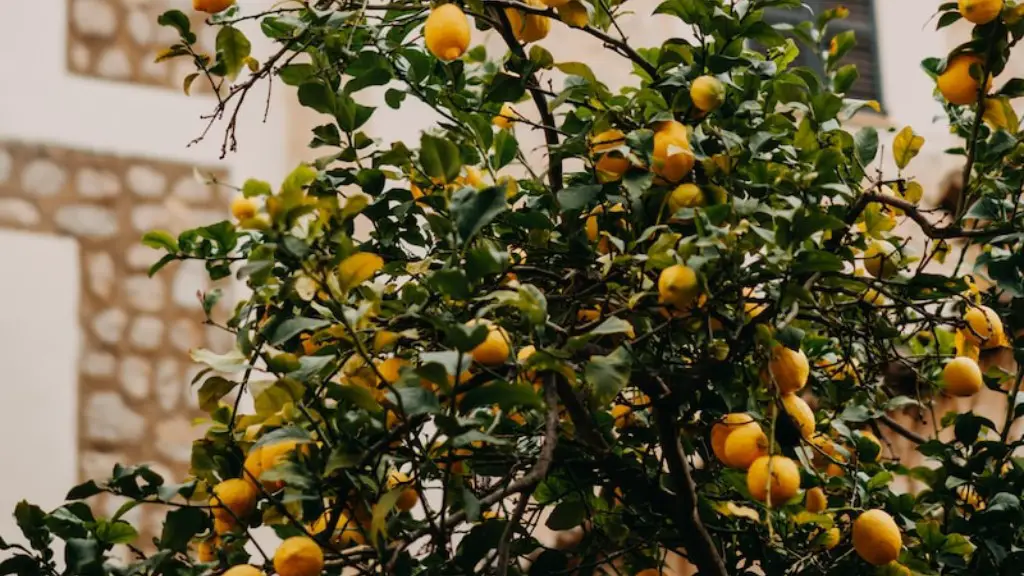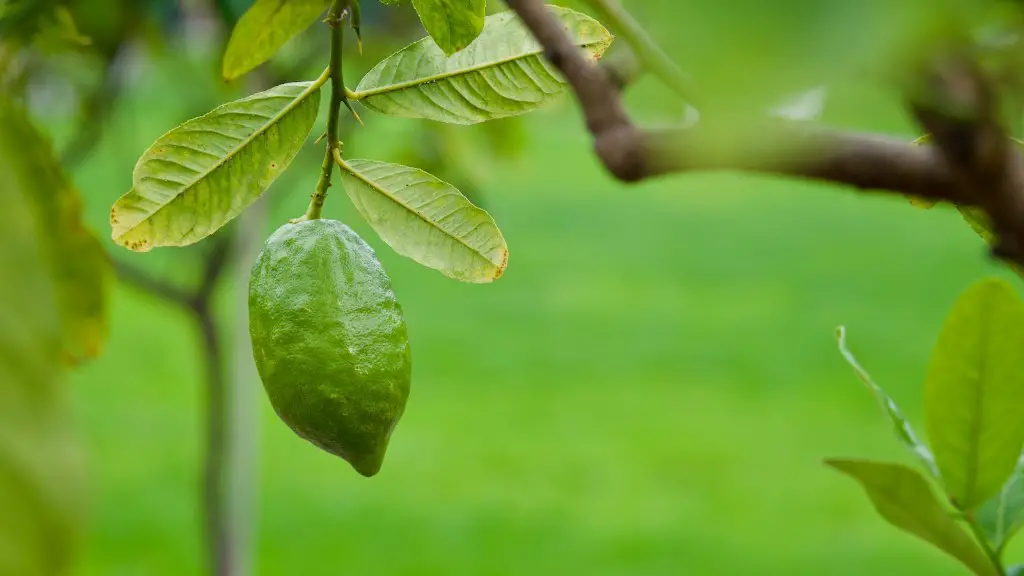No one wants to see their beloved lemon tree dropping flowers, so it is important to take action quickly to identify the underlying cause of the issue. The most commonly accepted explanation is environmental stress; this can be caused by a variety of different factors, including lack of water, root or nutrient deficiency, or improper pruning. In addition, other less common causes may include biological imbalances, such as pests, disease, or improper cultivation methods.
To determine if the flower drop is related to environmental stress, inspect the tree for signs of wilting or yellowing. Wilting or yellowing of the leaves can indicate an abundance of water stress in your tree. Additionally, look for pests, disease, or improper cultivation. If any of these factors appear to be present, taking action to mitigate their effects can help reduce the flower drop.
If environmental stress is ruled out, nutrient and root deficiencies can be the culprit. An unbalanced nutrient levels can cause the leaves to appear yellow or fuzzy, in addition to causing flower drop. To test for deficiencies, collect soil samples and inspect them for signs of nutrient depletion. Additionally, check for root problems, such as root rot or root compression. Both of these can cause stunted growth and failure for the lemon tree to absorb nutrients.
Finally, improper pruning can also contribute to flower drop in your lemon tree. Pruning should be done with extreme care and according to the specific needs of your tree. Improper pruning can damage the branches and leaves and reduce the tree’s ability to sustain flowering. To prevent this, always be sure to follow proper pruning techniques in order to ensure healthy growth and development.
Environmental Stress
Environmental stress is one of the primary reasons why lemon trees can drop flowers. Excessive water, root or nutrient deficiency, and improper pruning can all contribute to a decline in the tree’s production. When environmental issues are present, it is important to take action to mitigate their effects, such as ensuring proper watering or enhancing the quality of the soil. By doing so, you can help reduce the flower drop and maintain the health of your lemon tree.
It is also important to be aware of other potential causes, such as biological imbalances, in order to fully understand the cause of the flower drop. Pests, disease, and improper cultivation all have the potential to damage the tree, leading to reduced flowering and decreased production. Regularly inspecting the tree for such issues is crucial in order to maintain the health of your lemon tree.
Proper fertilizer can help alleviate some of the environmental stress that can cause your lemon tree to drop flowers. Fertilizers are often categorized as either quick-release or slow-release, and while they all help support the tree’s growth and health, slow-release varieties are generally preferred. Slow-release fertilizers help provide a steady dose of nutrients and allow the tree to absorb them over a longer period of time. This can help reduce extremes in nutrient availability and create a more balanced environment.
In addition, proper mulching can help mitigate the effects of environmental stress. Applying mulch around the lemon tree helps to retain moisture and protect the underlying soil from direct exposure to the sun. In addition, mulch helps to insulate the roots, allowing for more regular watering and providing a healthy growth environment.
Nutrient Deficiencies
If environmental stress is ruled out, nutrient or root deficiencies can be the cause of the lemon tree dropping flowers. A lack of proper nutrients can cause the leaves to appear yellow and fuzzy, in addition to causing flower drop. To test for these deficiencies, collecting soil samples and examining them for signs of nutrient depletion is an effective method. Additionally, it is important to check for any root problems, such as root rot or root compression. Both of these can lead to stunted growth of the lemon tree and reduce the ability of the tree to absorb the necessary nutrients.
Treating nutrient deficiencies often requires applying a fertilizer, such as a slow-release fertilizers. Slow-release fertilizers can help provide a steady supply of nutrients that the tree can absorb over a longer period of time, creating a more balanced environment and reducing the extremes between nutrient availability. For more severe cases, applying a liquid fertilizer may be necessary; however, it is important to be aware of the potential for over-fertilization, which can be detrimental to the tree’s health.
In addition, adding amendments to the soil, such as compost or manure, can help provide a healthy balance of macronutrients (i.e., nitrogen and phosphorus) and micronutrients (i.e., iron and zinc). Compost acts as a slow-release supply of nutrients and helps to maintain soil quality, improve soil drainage, and reduce extremes in nutrient availability. Manure, on the other hand, is excellent for improving soil fertility and increasing the nutrient content of the soil.
Finally, engaging in soil aeration can help alleviate some of the root deficiencies that can occur in lemon tree. Aeration helps to loosen the soil, allowing for better water drainage and improving the overall health of the root system. Additionally, aeration can help improve nutrient availability, as the added oxygen helps break down organic matter and convert it into usable nutrients.
Pruning Techniques
Improper pruning can be one of the primary causes of flower drop in lemon trees. Pruning should be done with extreme care and according to the specific needs of your tree in order to maintain its health and vigor. By pruning the branches and leaves correctly and taking the time to shape the tree in a manner that best supports its production, you can increase the chances of successfully maintaining its flowering.
It is also important to prune away any dead, diseased, or damaged branches and leaves, as these can be detrimental to the health of the tree. Moreover, pruning should be done in gradual steps, as too much pruning at once can create shock and lead to serious damage. It is also important to avoid pruning the tree during periods of extreme heat or cold as this can cause additional damage to the tree.
In addition to pruning, periodically trimming the tree can also help maintain optimal production. Regular trimming helps to keep the tree properly shaped and remove dead or diseased wood. Trimming should be performed with care, particularly when near fruit-producing branches, as too much trimming can negatively affect the tree’s fruit production.
It is also important to properly time the pruning of your lemon tree. To promote optimal flowering, it is best to prune the tree in late winter or early spring. During this time, the tree is dormant and more resistant to any damage that can be caused by the pruning. Moreover, pruning in the early spring months can help promote a flush of new growth and prepare the tree for the summer months.
Organic Stores and Products
Using organic products and materials can help support the health and production of your lemon tree. Organic products, such as compost, manure, and fertilizers, provide essential nutrients that help nourish the tree and promote strong root growth. In addition, organic pest and disease control products can help protect your tree from any potential threats and maintain its health.
Organic stores and farmer’s markets can be excellent sources for organic products and materials. In addition, many stores and markets offer educational resources to help better inform you of the best practices for caring for your lemon tree. Additionally, many stores and markets may have specialists on staff who can help answer any questions or concerns you may have.
It is also important to consider the use of natural repellents and beneficial insects in order to help protect the tree from potential pests and diseases. Natural repellents, such as garlic, chili pepper, and essential oils, can help keep harmful pests away and encourage beneficial insects, providing a more balanced environment for your tree.
Finally, it is important to always take necessary precautions when caring for your lemon tree. Proper sanitation and sanitation practices can help reduce the risk of pests and diseases, while wearing protective clothing and the use of protective equipment can help protect both you and the tree from any potential harm.




